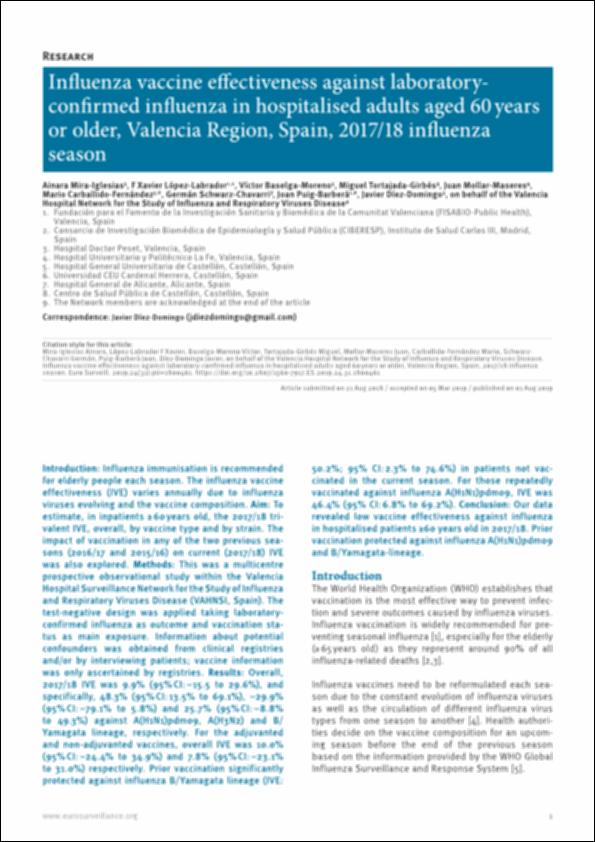Please use this identifier to cite or link to this item:
http://hdl.handle.net/10637/11636Influenza vaccine effectiveness against laboratory-confirmed influenza in hospitalised adults aged 60 years or older, Valencia Region, Spain, 2017-18 influenza season
| Title: | Influenza vaccine effectiveness against laboratory-confirmed influenza in hospitalised adults aged 60 years or older, Valencia Region, Spain, 2017-18 influenza season |
| Authors : | Mira Iglesias, Ainara López Labrador, F. Xavier Baselga Moreno, Víctor Tortajada Girbés, Miguel Mollar Maseres, Juan Carballido Fernández, Mario |
| Keywords: | Influenza - Vaccination - Spain - Valencia (Autonomous Community); Gripe - Vacunación - España - Comunidad Valenciana.; Older people - Vaccination - Spain - Valencia (Autonomous Community); Ancianos - Vacunación - España - Comunidad Valenciana. |
| Publisher: | European Centre for Disease Prevention and Control (ECDC). |
| Citation: | Mira Iglesias, A., López Labrador, FX., Baselga Moreno, V., Tortajada Girbés, M., Mollar Maseres, J., Carballido Fernández, M. et al. (2019). Influenza vaccine effectiveness against laboratory-confirmed influenza in hospitalised adults aged 60 years or older, Valencia Region, Spain, 2017-18 influenza season. Eurosurveillance, vol. 24 (1 aug.), n. 31, pp. 11-22. DOI: https://doi.org/10.2807/1560-7917.ES.2019.24.31.1800461 |
| Abstract: | Introduction: Influenza immunisation is recommended for elderly people each season. The influenza vaccine effectiveness (IVE) varies annually due to influenza viruses evolving and the vaccine composition. Aim: To estimate, in inpatients ≥ 60 years old, the 2017/18 trivalent IVE, overall, by vaccine type and by strain. The impact of vaccination in any of the two previous seasons (2016/17 and 2015/16) on current (2017/18) IVE was also explored. Methods: This was a multicentre prospective observational study within the Valencia Hospital Surveillance Network for the Study of Influenza and Respiratory Viruses Disease (VAHNSI, Spain). The test-negative design was applied taking laboratoryconfirmed influenza as outcome and vaccination status as main exposure. Information about potential confounders was obtained from clinical registries and/or by interviewing patients; vaccine information was only ascertained by registries. Results: Overall, 2017/18 IVE was 9.9% (95% CI: −15.5 to 29.6%), and specifically, 48.3% (95% CI: 13.5% to 69.1%), −29.9% (95% CI: −79.1% to 5.8%) and 25.7% (95% CI: −8.8% to 49.3%) against A(H1N1)pdm09, A(H3N2) and B/ Yamagata lineage, respectively. For the adjuvanted and non-adjuvanted vaccines, overall IVE was 10.0% (95% CI: −24.4% to 34.9%) and 7.8% (95% CI: −23.1% to 31.0%) respectively. Prior vaccination significantly protected against influenza B/Yamagata lineage (IVE: 50.2%; 95% CI: 2.3% to 74.6%) in patients not vaccinated in the current season. For those repeatedly vaccinated against influenza A(H1N1)pdm09, IVE was 46.4% (95% CI: 6.8% to 69.2%). Conclusion: Our data revealed low vaccine effectiveness against influenza in hospitalised patients ≥60 years old in 2017/18. Prior vaccination protected against influenza A(H1N1)pdm09 and B/Yamagata-lineage. |
| Description: | Este artículo se encuentra disponible en la página web de la revista en la siguiente URL: https://www.eurosurveillance.org/content/10.2807/1560-7917.ES.2019.24.31.1800461 También participan en la elaboración de este artículo científico: Germán Schwarz Chavarri, Joan Puig Barberà y Javier Díez Domingo. |
| URI: | http://hdl.handle.net/10637/11636 |
| Rights : | http://creativecommons.org/licenses/by/4.0/deed.es |
| ISSN: | 1560-7917. |
| Issue Date: | 1-Aug-2019 |
| Center : | Universidad Cardenal Herrera-CEU |
| Appears in Collections: | Dpto. Medicina y Cirugía |
Items in DSpace are protected by copyright, with all rights reserved, unless otherwise indicated.


